The Death of Last Click Attribution
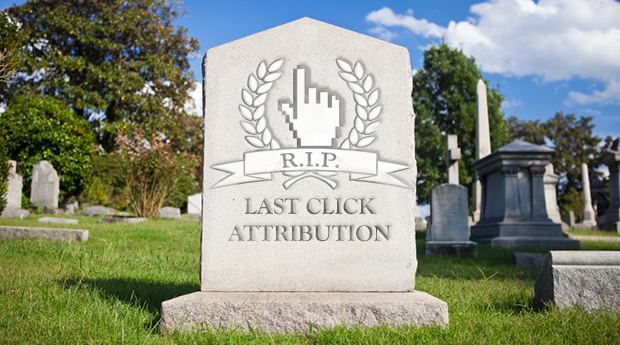
Almost everyone in digital marketing is slightly obsessed with Analytics. You might say that some of us are unhealthily obsessed. However, if you aren’t the type of person who has nightmares about anthropomorphized bounce rates growing to giant sizes until the room can’t contain them and they suffocate you (just me?), you may not be as familiar with the differences between “Last Click” attribution and “Multi-Channel” attribution.
What is Last-Click Attribution?
It may sound complicated, but it’s actually pretty simple. Take a look at this example:
I want to buy a dress for an upcoming holiday party. First, I go to Google and search for “holiday party dresses”. I click an organic listing for Piperlime and browse their selection. I don’t buy anything, but I later come back directly by typing www.piperlime.com into my URL bar. Again, I don’t buy anything, but I sign up for emails. Piperlime then emails me a sale promo, I click that email link, and I buy a dress.
In the past, Analytics was set up to give credit to the last action the user took before a conversion. In this case, the credit would be given to the email I received. But shouldn’t organic search be given some credit, since it’s what caused my initial brand interaction?
Despite massive shifts and innovations in digital marketing, Analytics has largely remained the same—a cookie-based tracking technology that offers up the same data (visits, time on site, traffic sources, conversions, etc.) that is has since its beginnings.
The problem is that this assumes that people are waaaay less complicated than they really are. Very few people buy anything after one brand interaction. We’re comparison shoppers. We want the best deals. I don’t buy anything until I’m sure I’ve found the best item at the best price.
Because of this, it’s time we change the way we measure channel success. Optimizing based off last-click attribution just doesn’t make sense anymore.
Multi-Channel for the Masses
Luckily, it’s easier than ever to track users as they go through multiple touch points prior to converting. We typically call this the ‘buying cycle’. Multi-channel tracking has been available for years; however, it’s only recently been made available to a wider audience and to companies with lower budget resources.
Now, it’s easy for any website to see their online buyer journey data with the free version of Google Analytics. Just open GA, click “Conversions”, then “Multi-Channel Funnels”. While you may need more advanced knowledge of GA to get to some of the really interesting data, Assisted Conversion information, Conversion Paths, and Path Lengths are all easily viewed from the main menu.
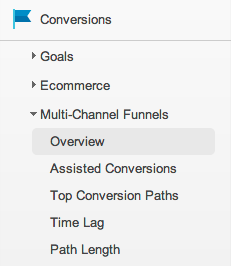
Multi-Channel Models
So, you have all this interesting data about customer buyer journey paths, but what can you actually do with it? And how does it affect your marketing budgets and bottom line?
This often depends on the attribution model that you choose to apply. Unfortunately, there are several models, and it can be difficult to determine which model works best for you and your company. The most common attribution models are Last Interaction, First Interaction, Linear, Time Decay, and Position Based.
To explain the differences in these models, let’s go back to the Holiday Dress example. In this simplified example, there were three touch points prior to conversion, in this order: organic search, direct traffic, and email marketing.
First Interaction Modeling
First Interaction modeling gives 100% of the credit to the first interaction. In this case, that would be the organic search query. This can make sense, as it was the first touch point that drove brand awareness. However, it discredits any future marketing efforts. In my opinion, this model doesn’t give enough credit to secondary touch points, which can ultimately drive that potential customer to become an actual customer.
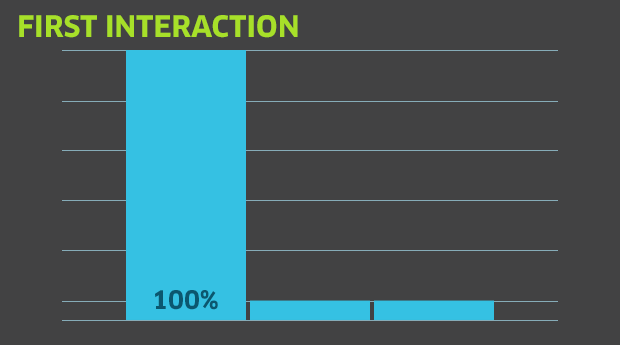
Last Interaction Modeling
Last Interaction modeling gives 100% of the credit to the last interaction prior to conversion. In our example, that would be email marketing. Personally, this is my least favorite model, but it can make sense in that it WAS the last thing that someone did prior to converting. So, you could make the case that the last interaction was the final driver to conversion.
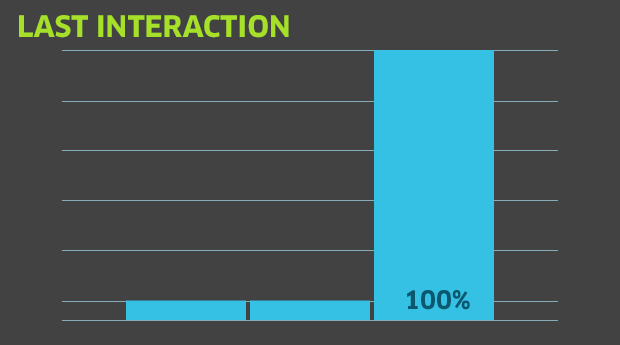
Linear Modeling
Linear modeling gives equal credit to every touch point. This can make sense if your campaigns are designed to target people at every stage of their decision cycle, and each campaign is designed to move the customer to the next step in their buyer journey.
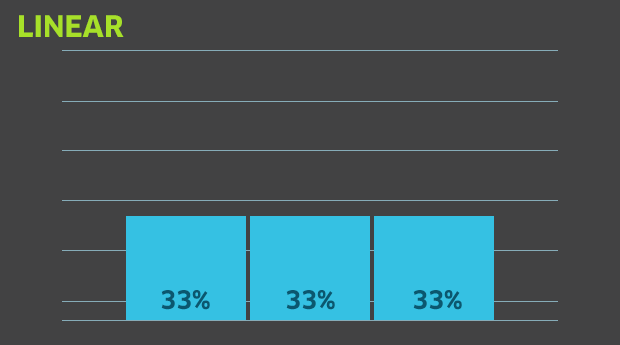
Time Decay Modeling
The Time Decay model assigns more credit as the customer gets closer to conversion. In our example, organic search would get the least credit, direct traffic would get more credit, and email marketing would get the most credit.
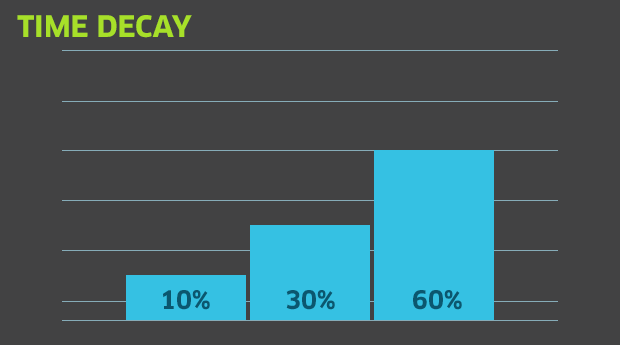
Position Based Modeling
A Position Based model allows you to give credit to touch points based on the position in the customer buyer journey. With this model, you can give more credit to the first touch point and the last touch point. I tend to favor this model, as it often makes sense to give more credit to the first campaign to drive awareness, and the last campaign that closed the sale.
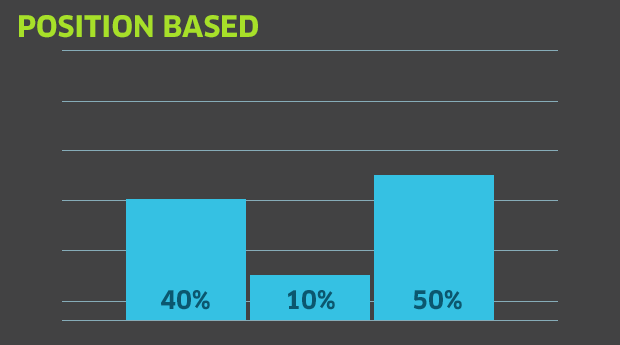
Choosing Your Model
It can be really difficult to choose which Attribution Model you should use. There is no right answer for everyone. When thinking about Attribution Modeling for your business, think about your marketing goals, your current marketing campaigns, and your sales cycle. These factors, combined with your intuition, are typically enough to determine the most appropriate model for you.
The good news is that, like most things in digital marketing, your attribution model decision doesn’t have to be final. Currently, Google Analytics Premium allows you to easily evaluate your data with each model I’ve discussed.
If you are lucky enough to have GA Premium, just navigate to the Multi Channel Funnels section and select the different model types. Start with last click – this is how your data is typically displayed in most Analytics platforms. Then test out the different models. You might be surprised how much a certain channel contributes to end conversions. Keep an eye out for assisted conversions from social campaigns – this is typically an eye opener to the monetary value of social media.
[caption id="attachment_12410" align="alignnone" width="620"] Assisted conversion value from Social Networks can be surprising, as seen here.[/caption]
Assisted conversion value from Social Networks can be surprising, as seen here.[/caption]
If you, like most people, don’t have GA Premium, don’t worry! Google has announced that they will be rolling out this option to the non-paid version of Analytics in 2013.
Summary
Marketers have more data easily available to them than ever before. Are there still gaps in data? Of course. We still can’t account for multi-device purchase paths, or perfectly reconcile offline purchase to online campaigns. However, isn’t it better to optimize for the great information that we do have available than to move forward blindly?
Even without a modeling tool, multi-channel data can be extremely valuable in determining what keywords or campaigns are critical in assisting conversions. If you are solely relying on last-click data, you are missing out on the big picture – and could risk recommending that budgets are cut in channels that are vital to your bottom line.
So, what do you think? Are you using a specific attribution model? How has it changed your marketing efforts? Did you find any surprisingly valuable channels that didn’t shine through in a last-click model?
If you haven’t checked out this data, yet, please do so! I guarantee you’ll find some interesting information. And, if you happen to work in social media, I accept thanks in the form of beer.

Comments
Add A CommentHi,
I notice that for many Time Decay Attribution model examples, the sum of attribution is always 100%. I want to understand why.
Say the half life is set to 1 day, and there is 1 conversion. And for this conversion, there is an exposure 1 day prior to the conversion, Therefore, this exposure gets attribution of 50%. But there is also an exposure 2 days prior, so that exposure should get attribution of 25%. This adds up to 75%.
Since decay of each exposure is independent of one another, there is no guarantee the attribution total will be 100% it could be more than 100% if you have three or more exposures that are very close together like 50%, 40%, 30%. But it could also be less than 100%, like my example, which only sums up to 75%.
So could you explain to me how attribution in time decay model is calculated? and how can the sum be 100%?
Thanks for your explanation.
As an FYI, my blog post on Campaign Attribution is now live. I have quickly discovered I need to do an extended version to detail my thinking behind the presentation notes.
Kimm - agree on evolving to the best solutions currently available, I just think we have alternatives to campaign attribution models.
Robert - I disagree on the idea of forcing / encouraging visitors to login, I just can't see the value in it to them. As with my comment to Kimm, agree that we should focus on the existing data, just believe that we should look at it in a different way.
I agree that universal analytics does pose challenges to most sites because of universal login issues, but why do we tend to discount the creation and adoption of those? As marketers, I believe we should be encouraging users to gain value from our sites. One way universal logins could aid in this would be to provide responsive content to users based on their login and past site experiences. Amazon does a great ob of this, as does Google with personalized results and a login that works across all of their products. These are giants of course, but as marketers we should be able to find a way to extend this to our smaller clients.
It's definitely a challenge to encourage account creations unless you can truly convey your value to a user, but I believe going beyond the technology that is currently available for marketers to track their users will fall into a much larger legal, ethical, and political battle. And seeing that the current atmosphere tends to be "marketers are evil because they want to track us", I can't foresee the outside world being in favor of even more tracking.
Maybe I'm wrong, maybe there is already something out there that can solve this; however, I do have to agree with Kimm on focusing on the data we do have currently. Unfortunately, most marketers don't utilize most of the data they have to make data driven decisions (If they did, Avinash would probably be retired by now). Marketing can never be perfect, data sets will never be complete, there's always something we could have done better. What we can do is focus on providing value, look at the data we have, and make decisions on how to get better, over and over and over again.
Hi Peter - I think if there is one truth it's that there will always be a better solution soon :) I just think it's better to evolve to the solutions we have, instead of staying stagnate. I do agree that Universal Analytics isn't the answer, unless you happen to require a login. I look forward to reading your piece!
Thanks for the response Robert/Kimm. Universal Analytics is not going to solve this without universal login. A small minority of websites require login or use a common visitor identifier and without that you simply cannot link touchpoints. It is definitely not possible to include touchpoints like watching a TV ad or chatting to your neighbour - two of many factors that could have a massive impact on a purchase decision.
I disagree in this case that we should rely on the data we have, as it is incomplete (as opposed to a subset), it can lead to incorrect decisions. Instead I think we should be looking for alternatives to campaign attribution & focusing on what questions are we really trying to answer (and why). I spoke at eMetrics London last week on the topic - hope to have the presentation on my blog within the next week - where you will be free to comment/disagree in turn.
Hi Peter,
That is a great question, and although I touched on the multi-device problem in the summary, that issue alone is so complex that it deserves its own post! I know that Google will be working on solutions for this in the coming year; although with their concern for privacy issues, I don't think they can/will fully solve this anytime soon. I still think it's better to optimize for all the great data we do have available, than to ignore it. Who knows, maybe in a few years we'll have Google Iris Tracking :)
Hi Peter, that's a great question that has troubled analysts and marketers for quite some time. Thankfully, Google has produced a new beta version of GA called Universal Analytics that allows tracking to become cross device and platform. It's still in a pretty limited beta at the time, but if you want to learn more about it you can go here, http://support.google.com/analytics/bin/answer.py?hl=en&answer=2790010&topic=2790009&ctx=topic
Hi - nice summary of the different attribution models. But how do you propose doing this if the organic search was on your work computer, when you got home, you went directly to the website via your personal computer and then ended up purchasing via that email on your phone? The journey then would appear in any analytics tool to be visits from three different people, all of a single visit each. Kinda breaks all campaign attribution models...